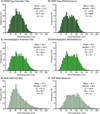Collagen V expression is crucial in regional development of the supraspinatus tendon
- PMID: 28005290
- PMCID: PMC5189919
- DOI: 10.1002/jor.23246
Collagen V expression is crucial in regional development of the supraspinatus tendon
Abstract
Manipulations in cell culture and mouse models have demonstrated that reduction of collagen V results in altered fibril structure and matrix assembly. A tissue-dependent role for collagen V in determining mechanical function was recently established, but its role in determining regional properties has not been addressed. The objective of this study was to define the role(s) of collagen V expression in establishing the site-specific properties of the supraspinatus tendon. The insertion and midsubstance of tendons from wild type, heterozygous and tendon/ligament-specific null mice were assessed for crimp morphology, fibril morphology, cell morphology, as well as total collagen and pyridinoline cross-link (PYD) content. Fibril morphology was altered at the midsubstance of both groups with larger, but fewer, fibrils and no change in cell morphology or collagen compared to the wild type controls. In contrast, a significant disruption of fibril assembly was observed at the insertion site of the null group with the presence of structurally aberrant fibrils. Alterations were also present in cell density and PYD content. Altogether, these results demonstrate that collagen V plays a crucial role in determining region-specific differences in mouse supraspinatus tendon structure. © 2016 Orthopaedic Research Society. Published by Wiley Periodicals, Inc. J Orthop Res 34:2154-2161, 2016.
Keywords: EDS; collagen; fibril; supraspinatus; tendon.
© 2016 Orthopaedic Research Society. Published by Wiley Periodicals, Inc.
Figures







Similar articles
-
In situ fibril stretch and sliding is location-dependent in mouse supraspinatus tendons.J Biomech. 2014 Dec 18;47(16):3794-8. doi: 10.1016/j.jbiomech.2014.10.029. Epub 2014 Oct 31. J Biomech. 2014. PMID: 25468300 Free PMC article.
-
Collagen V haploinsufficiency in a murine model of classic Ehlers-Danlos syndrome is associated with deficient structural and mechanical healing in tendons.J Orthop Res. 2017 Dec;35(12):2707-2715. doi: 10.1002/jor.23571. Epub 2017 Apr 24. J Orthop Res. 2017. PMID: 28387435 Free PMC article.
-
Three-dimensional ultrastructural analysis of development at the supraspinatus insertion by using focused ion beam/scanning electron microscope tomography in rats.J Orthop Res. 2016 Jun;34(6):969-76. doi: 10.1002/jor.23111. Epub 2015 Dec 10. J Orthop Res. 2016. PMID: 26599103
-
Development of tendon structure and function: regulation of collagen fibrillogenesis.J Musculoskelet Neuronal Interact. 2005 Mar;5(1):5-21. J Musculoskelet Neuronal Interact. 2005. PMID: 15788867 Review.
-
Experimental evaluation of multiscale tendon mechanics.J Orthop Res. 2017 Jul;35(7):1353-1365. doi: 10.1002/jor.23488. Epub 2017 Apr 19. J Orthop Res. 2017. PMID: 27878999 Review.
Cited by
-
Mature murine supraspinatus tendons demonstrate regional differences in multiscale structure, function and gene expression.PLoS One. 2025 Feb 20;20(2):e0318809. doi: 10.1371/journal.pone.0318809. eCollection 2025. PLoS One. 2025. PMID: 39977400 Free PMC article.
-
Collagen XI regulates the acquisition of collagen fibril structure, organization and functional properties in tendon.Matrix Biol. 2020 Dec;94:77-94. doi: 10.1016/j.matbio.2020.09.001. Epub 2020 Sep 17. Matrix Biol. 2020. PMID: 32950601 Free PMC article.
-
Basic Structure, Physiology, and Biochemistry of Connective Tissues and Extracellular Matrix Collagens.Adv Exp Med Biol. 2021;1348:5-43. doi: 10.1007/978-3-030-80614-9_2. Adv Exp Med Biol. 2021. PMID: 34807414
-
Tendon Extracellular Matrix Assembly, Maintenance and Dysregulation Throughout Life.Adv Exp Med Biol. 2021;1348:45-103. doi: 10.1007/978-3-030-80614-9_3. Adv Exp Med Biol. 2021. PMID: 34807415 Review.
-
Age-associated changes in the response of tendon explants to stress deprivation is sex-dependent.Connect Tissue Res. 2020 Jan;61(1):48-62. doi: 10.1080/03008207.2019.1648444. Epub 2019 Aug 14. Connect Tissue Res. 2020. PMID: 31411079 Free PMC article.
References
-
- Ainsworth SR, Aulicino PL. A survey of patients with Ehlers-Danlos syndrome. Clin Orthop Relat Res. 1993:250–256. - PubMed
-
- Stanitski DF, Nadjarian R, Stanitski CL, et al. Orthopaedic manifestations of Ehlers-Danlos syndrome. Clin Orthop Relat Res. 2000:213–221. - PubMed
-
- Symoens S, Syx D, Malfait F, et al. Comprehensive molecular analysis demonstrates type V collagen mutations in over 90% of patients with classic EDS and allows to refine diagnostic criteria. Hum Mutat. 2012;33:1485–1493. - PubMed
-
- Malfait F, De Paepe A. The Ehlers-Danlos syndrome. Advances in experimental medicine and biology. 2014;802:129–143. - PubMed
-
- Malfait F, Coucke P, Symoens S, et al. The molecular basis of classic Ehlers-Danlos syndrome: a comprehensive study of biochemical and molecular findings in 48 unrelated patients. Hum Mutat. 2005;25:28–37. - PubMed
Publication types
MeSH terms
Substances
Grants and funding
LinkOut - more resources
Full Text Sources
Other Literature Sources

